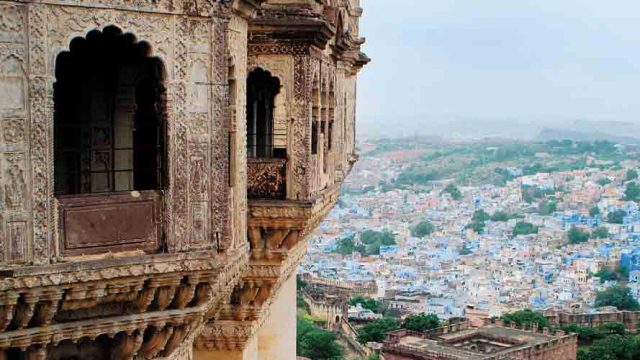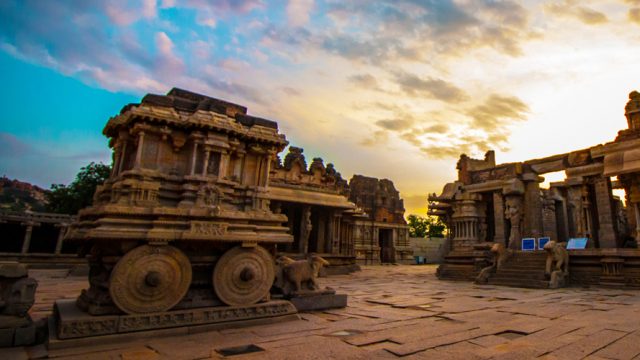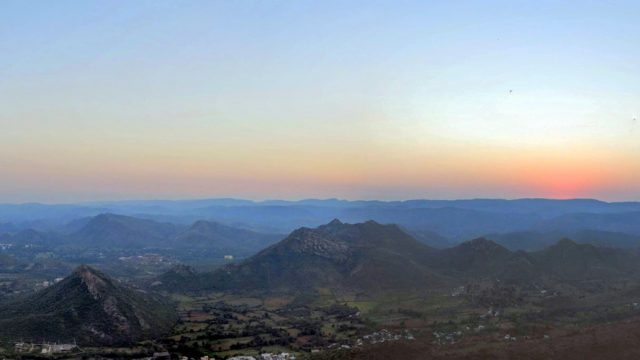Jodhpur’s colourful and lively walled city is crammed with ancient havelis. But although I walked
Dehydrated and dusty, I stopped to buy a bottle of water from a handicraft shop that also housed a travel agency and an STD booth, and asked the proprietor if he had heard of a newly opened, super-exclusive haveli-boutique hotel called Raas. He pointed up the road I had come: “It’s right there.”
A few steps back down in the gali there was indeed a majestic though unmarked gate in a high wall, next to an ancient stepwell. An old chowkidar appeared out of nowhere, swinging the gate open for me. And there it was: perhaps the only hotel in Jodhpur that doesn’t fill its neighbourhood with signboards advertising its existence.
The moment I stepped into its oasis of calm, I knew that this was the obvious choice for any discerning traveller—and I sincerely hoped that some form of discernment radiated from my puffy and desert-grime-covered face.
The transition — as I walked past the reception desk and entered through a second gateway (this one modern, stark, stylish) into the yard where a couple of old structures serve as restaurants, spa and heritage suites — was stunning. The high walls cut off the noise from outside and a cool Lou Reed song, followed by Edith Piaf, played discreetly from speakers spread across the 1.5-acre property.
I lifted my gaze and, right above me, so close that I felt I could reach out and touch it, was the high cliff on which Rao Jodha started building the impressively massive Mehrangarh citadel in 1459. Most of what we see today is of course from the 1600s, but the citadel remains one of Asia’s iconic edifices. Beneath the cliff there are clusters of blue town houses; some people will tell you that termites — or perhaps mosquitoes—were repelled by ingredients in the paint. Others claim that the Brahmins painted their houses with a whitewash that contained a dash of indigo so that enemies attacking the town wouldn’t slaughter them by mistake. Since that sort of wanton slaughtering has grown increasingly rare, people in Jodhpur paint their houses any fancy colour they like. But the management at Raas ensures that its guests have a traditional view by offering house owners on the Raas-facing side of the cliff a Diwali gift of a free blue paint-job. That’s a typical example of Raas’s attention to detail.
Another noteworthy detail is that almost all the rooms have balconies facing Mehrangarh. So you can have your tea or tipple and watch the fort as the sun sets. Or soak in your bathtub — like I did, as my travel-weary bones snapped, crackled and popped back in place — and peek out through the screened bathroom window.
The rooms are all set in ultramodern, sleekly designed blocks and their interiors are again a stark contrast to the outside world. For a moment I felt like I had morphed into a macho hunk of a model starring in an ad film for a high-end home theatre system or something. The floors and beds are made of black, hand-polished terrazzo, the walls of hand-cut thick rosy sandstone slabs, and the balcony is equipped with an ingenious sliding sandstone shutter screen.
Raas will soon unveil three heritage suites crafted out of former zenanas. And although the work is still underway (when the owners bought this haveli, a former city residence of the Thakurs of Raas village, it was a debris-covered ruin that practically had to be excavated), it is easy to see that these suites are going to be out-of-this-world spectacular. Each will have private indoor and outdoor lounge areas, and open-air bathtubs or jacuzzis.
At night the grounds are lit up by hundreds of diyas, and after a relaxing massage at the in-house Serena Spa, you can hang out in the multi-cuisine Baradari Café, which is housed in the old darbar hall. Unfortunately the hotel’s main speciality restaurant was still under construction at the time we visited.
The hotel is eco-friendly, with solar water-heating; the water is recycled and used for gardening. Interestingly the elegant furniture wasn’t imported but custom-made from salvaged teakwood by a Jodhpur-based carpenter of Italian origin.
In effect, Raas is easily the most perfect hotel experience that Jodhpur’s old town has to offer. It is extremely conveniently located for forays into the bazaars—shop for cloth in Kapron ka Bazaar, jewellery in Sarafa Bazaar, spices in Mirchi Bazaar and so on. During 2010, as an opening-year offer, Raas provides its guests with a free guided heritage walk, conducted by a knowledgeable staff member who will show you the marvels and secrets of the old town.
If I was the fruit of a slightly better family tree, I could have been a maharaja and lived permanently in one of Rajasthan’s many palatial hotels, I think to myself as I travel on to Rohetgarh, founded in 1622, and about an hour’s drive from Jodhpur.
I’m told that Rao Jodha, the builder of Jodhpur, had a brother, Dalpat Singh, who became the Thakur of Rohet. Dalpat Singh’s clan were prominent breeders of Marwari battle horses. His descendants still live here in a set of beautifully rustic fortified bungalows. The present Thakur, Manvendra Singhji Rathore, takes genuine delight in receiving paying guests into his home, and the famous Marwari horses still stand in their stables, waiting to take you on a safari or picnic. (For true horse-lovers, there’s even one room with a panoramic window opening into the stables so that you and the horses can keep an eye on each other at all times.)
After Independence, when feudal career options suddenly shrank, the current Thakur became a history teacher at Ajmer’s Mayo College. In the 1980s, he met a 20-something English writer who was looking for a quiet room in which to write. Being a hospitable man, Thakur Singhji invited him home and put him up for a couple of months. (After all, the family’s motto has been, since the times of hoary yore, “Life is to give, not to take.”) The writer was Bruce Chatwin and the book he wrote was The Songlines.
I later checked Nicholas Shakespeare’s biography of Chatwin, and Rohetgarh is indeed described as a “writer’s paradise” for Chatwin who wrote long letters home praising his marvellous accommodation (and host). Towards the end of the 1980s, the Thakur decided to open up his home as a hotel and one of the first guests was William Dalrymple, who promptly checked into Chatwin’s room (Suite No. 15) to write his City of Djinns at the very same desk. Other writers who have stayed here include Simon Winchester and Patrick French.
Of course, these days guests are more excited at the thought that Madonna and Guy Ritchie holidayed here, although apart from a night in suites above the stables the celebrity couple mostly hid out in one of the newer properties that the Thakur’s son and daughter-in-law, Sidharth and Rashmi Singh, have developed out in the desert.
The best way to get to their Wilderness Camp is on a safari — horse, camel or jeep. On the way, I visited villages of extraordinary charm, including one hamlet that featured in the Adrien Brody and Irffan Khan-starrer The Darjeeling Limited. The camp, which Madonna rented in its entirety, is great for nature lovers, although only operational in season.
A short distance from it stands the latest permanent addition to the hotel portfolio, which opened at the end of last year: Mihirgarh or the Sun Fortress.
This rural retreat has been a long-time dream project for the Singhs. The exquisite pleasure palace, standing on top of a sand dune at the desert’s edge, is sheer fantasy come alive: it is so mirage-like that I found myself expecting it to vanish any moment. But I promise you that the castle is very solidly set in the sand.
It is perhaps best described as Walt Disney goes to Morocco to remake A Thousand and One Nights, a quirkily charming super-luxury sandcastle, its 1,700-sq-ft suites furnished with a combination of appealing old-style objects (cupboard with flaked blue paint, faux-antique bathtub on graceful eagle legs, enough handicrafts to fill a government emporium) and modcons (AC, Wi-Fi, plasma television, DVD player). All suites have private open-air patios, ground-floor terraces feature plunge pools, while up in a mud-plastered turret you can chill out in a jacuzzi that overlooks miles of arid country.
A distinguishing feature at Mihirgarh is its airiness: it has several courtyards, the rooms feel lavishly big, plenty of windows open out onto endless vistas, and depending on if you’re an early bird or a night owl you could request a sunrise or sunset view suite. Furthermore, depending on the willingness of the abundant wildlife, you may spot black buck and nilgai, or a huge eagle resting in the shade of a small tree, and flocks of peacocks — so no need to switch on the TV, really.
Even if the hotel is completely booked, it’s likely that you will find your own little nook or cranny. Being fond of facts and figures, I estimated that this 11-bed hotel (the family suite has two extra beds) comfortably seats 200 people on all its divans, sofas, deck chairs, café chairs and cushioned niches carved into mud walls in the many different rooms, courtyards, lounges, balconies and terraces.
The rustic chic finish — Mihirgarh is built of mud and wattle — gives it a down-to-earth feel; the sand-coloured building merges with the surrounding landscape and you feel that you’re hiding at the end of the world.
That idea of creating a peaceful hideaway is what unites Mihirgarh and Raas, the two newest offerings from Rajasthan’s amazing hospitality industry.
The information
Getting there: The hotels featured in the article are all in, or accessible from, Jodhpur. BY AIR There are flights from Delhi, Mumbai, Jaipur and Udaipur (20min to Jodhpur town; 1hr to Rohet village). BY RAIL There are direct trains from almost every corner of India, including Bengaluru, Chennai, Guwahati, Howrah and Thiruvananthapuram.
Where to stay: Raas is set in Jodhpur’s old walled city, 5min from the Clock Tower. They currently offer 32 rooms and four duplex suites. Another three heritage suites will open by September. Tariff Rs 13,000-16,000 (rooms)/Rs 23,000 (suites), including breakfast. Discounts of up to 40% will be on offer from mid-April. Contact 0291-2636455, www.raasjodhpur.com
Rohetgarh, in Rohet village, has 29 rooms and six suites, all different — some have lake views, others have private balconies. Tariff Rs 4,000-5,000 (rooms)/Rs 7,500 (suites). Contact 0291-2431161, 02936-268231, www.rohetgarh.com
Mihirgarh is located west of Khandi village, 17km from Rohet/55km southwest of Jodhpur. There are eight suites and one two-bedroom family suite. Tariff Rs 24,000/ Rs 33,600 (family suite), including meals, one jeep safari and free IMFL (till September). Contact 9829023453, 9636169665, www.mihirgarh.com
The Wilderness Camp is adjacent to Mihirgarh (1km) and has seven luxury tents with attached bathrooms and very high comfort level, but is closed from end-March to September. Tariff Rs 11,500
What to see & do: Jodhpur is a large city with all manner of facilities, including plenty of travel agents to organise tours to Bishnoi villages and safaris. Its Clock Tower Market is apparently one of the ‘100 Great Markets of the World’. Even if you don’t want to shop, you should try the unbelievably creamy lassi offered at Mishrilal’s in the gateway.
In Rohetgarh, go on birdwatching and wildlife safaris (Rs 750 by bicycle or jeep, Rs 1,500-9,500 by horse; the latter includes meals and overnight camping).
Mihigarh
Rajasthan
Leave a Reply
You must be logged in to post a comment.





